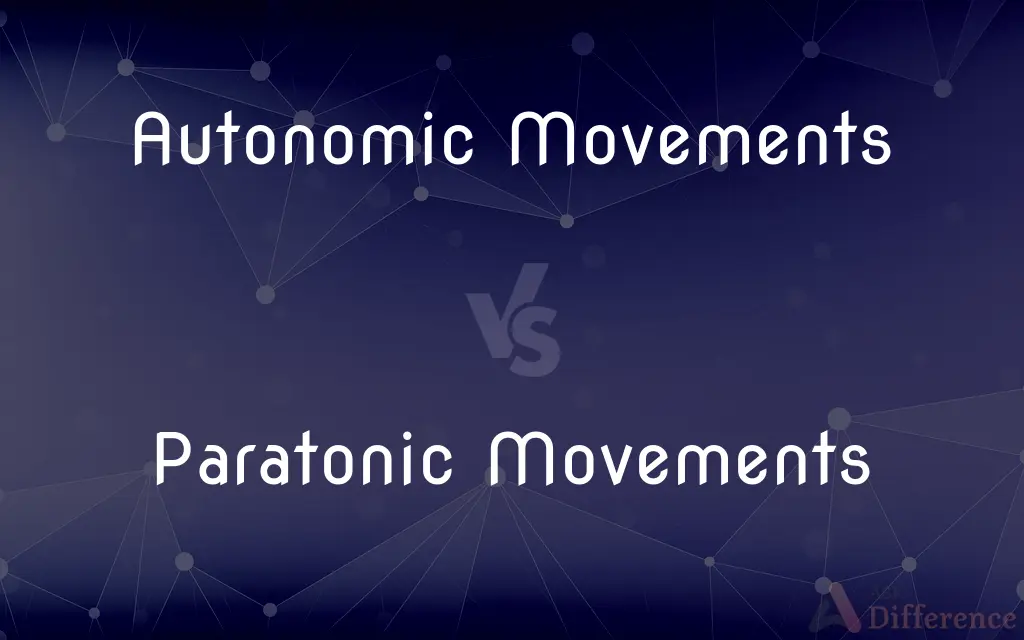Autonomic Movements vs. Paratonic Movements — What's the Difference?
By Fiza Rafique & Urooj Arif — Published on August 5, 2024
Autonomic movements are involuntary actions controlled by the autonomic nervous system, regulating internal organs, whereas paratonic movements are resistive reactions to external forces, not originating from internal stimuli.

Difference Between Autonomic Movements and Paratonic Movements
Table of Contents
ADVERTISEMENT
Key Differences
Autonomic movements are governed by the autonomic nervous system (ANS), which operates unconsciously to manage vital functions such as heart rate, digestion, and respiratory rate. These movements are crucial for maintaining homeostasis and responding to internal changes without conscious effort. On the other hand, paratonic movements occur as a response to external manipulations or forces acting upon the body, such as resistance offered when a limb is passively moved by another person or a device. These movements are not initiated by the organism but are reactions to external stimuli.
The ANS divides into the sympathetic and parasympathetic nervous systems, with autonomic movements facilitating the body's fight-or-flight responses or rest-and-digest processes. This intricate balance ensures survival and energy conservation. Paratonic movements, however, are more about the mechanical response of muscles and joints to external pressures, aiding in the assessment of muscle tone and neurological function during physical examinations.
Autonomic movements include processes such as the adjustment of pupil size in response to light, sweating to regulate body temperature, and the modulation of blood vessels' diameter to maintain blood pressure. These actions are reflexive and serve continuous physiological regulation. Conversely, paratonic movements, like the increase in muscle tone when trying to move a joint through its range of motion against a patient's resistance, help healthcare professionals evaluate the integrity of the musculoskeletal and nervous systems.
The regulation of autonomic movements is deeply embedded within the body's internal monitoring systems, requiring no conscious thought, thus allowing individuals to adapt to internal and external environmental changes seamlessly. Paratonic movements, however, involve a more passive interaction with the environment, often utilized in therapeutic settings to assess and improve physical conditions.
While autonomic movements are essential for survival by maintaining internal equilibrium and responding to emergencies, paratonic movements serve as indicators of physical health and are used diagnostically to detect abnormalities in muscle tone or neurologic impairments.
ADVERTISEMENT
Comparison Chart
Control System
Autonomic nervous system (ANS)
External forces
Volition
Involuntary, automatic
Induced, passive
Purpose
Regulate internal organ function, maintain homeostasis
Assess muscle tone, neurological function
Origin
Internal physiological stimuli
External physical manipulation
Examples
Pupil dilation, sweating, heart rate adjustment
Resistance in muscle movement against external force
Compare with Definitions
Autonomic Movements
Digestive processes regulation.
Autonomic movements in the digestive tract ensure efficient nutrient absorption.
Paratonic Movements
Increased muscle tone during stretching.
Observing paratonic movement when stretching indicates muscle health.
Autonomic Movements
Pupil dilation in response to light.
In dim lighting, autonomic movement causes pupils to dilate for better vision.
Paratonic Movements
Resistance to passive limb movement.
The increased paratonic movement when a physiotherapist moves a patient's arm.
Autonomic Movements
Involuntary control of heartbeat.
The heart's autonomic movement increases during exercise to meet the body's oxygen demand.
Paratonic Movements
Response to external pressure on muscles.
Muscles show paratonic movement when pressed during a massage.
Autonomic Movements
Sweating for thermoregulation.
Autonomic movements trigger sweating to cool the body during high temperatures.
Paratonic Movements
Rigidity encountered in neurological examinations.
Paratonic movements help diagnose conditions like Parkinson's disease.
Paratonic Movements
Diagnostic tool for muscle functionality.
Paratonic movements are assessed to evaluate muscle and joint integrity.
Common Curiosities
What are autonomic movements?
Autonomic movements are involuntary actions regulated by the autonomic nervous system, crucial for maintaining body functions without conscious effort.
What defines paratonic movements?
Paratonic movements are resistive responses to external manipulations, reflecting muscle tone and neurological health rather than internal regulation.
How do autonomic and paratonic movements differ in control?
Autonomic movements are controlled by the autonomic nervous system internally, while paratonic movements result from external physical interactions.
Can paratonic movements be controlled voluntarily?
No, paratonic movements are not voluntarily controlled; they are passive responses to external forces.
What is an example of a paratonic movement in physical therapy?
An example is the resistance felt when a therapist moves a patient's limb to assess joint mobility or muscle health.
Can lifestyle affect autonomic movements?
Yes, factors like stress, nutrition, and exercise can influence the efficiency of autonomic responses.
How are paratonic movements used in healthcare?
They are used to assess muscle tone, flexibility, and neurological function during physical examinations and rehabilitation.
How does the body regulate autonomic movements?
Through the sympathetic and parasympathetic nervous systems, balancing the body's fight-or-flight and rest-and-digest responses.
How does aging affect autonomic and paratonic movements?
Aging can lead to decreased autonomic efficiency and altered paratonic responses, impacting overall health and mobility.
What role do autonomic movements play in survival?
They regulate essential bodily functions like heart rate, digestion, and temperature, ensuring the body's adaptation to internal and external changes.
Do paratonic movements indicate pathology?
They can, as abnormal resistance or rigidity during movement may signal neurological or muscular issues.
Why are paratonic movements important in neurological assessments?
They provide insight into the health of the musculoskeletal and nervous systems, aiding in the diagnosis of disorders.
Are autonomic movements conscious?
No, autonomic movements are unconscious processes that regulate vital body functions without the need for conscious input.
Is feedback from paratonic movements useful in rehabilitation?
Yes, it assists therapists in tailoring treatments to improve muscle tone, flexibility, and neurological recovery.
Are there exercises to improve autonomic function?
While autonomic functions are involuntary, lifestyle changes and stress management techniques can optimize their efficiency.
Share Your Discovery

Previous Comparison
AC Power vs. DC Power
Next Comparison
Sprouts vs. MicrogreensAuthor Spotlight
Written by
Fiza RafiqueFiza Rafique is a skilled content writer at AskDifference.com, where she meticulously refines and enhances written pieces. Drawing from her vast editorial expertise, Fiza ensures clarity, accuracy, and precision in every article. Passionate about language, she continually seeks to elevate the quality of content for readers worldwide.
Co-written by
Urooj ArifUrooj is a skilled content writer at Ask Difference, known for her exceptional ability to simplify complex topics into engaging and informative content. With a passion for research and a flair for clear, concise writing, she consistently delivers articles that resonate with our diverse audience.













































